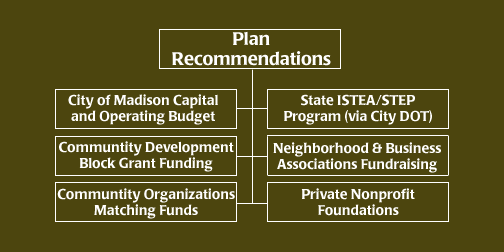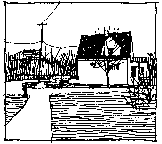The neighborhood has a long history of planning for its future. The purposeof this plan is to identify the major issues facing the neighborhood, formulatestrategies to achieve desired outcomes, and set the foundation for collaborativeefforts between public and private sectors to help implement the plan recommendations.
Why was the Tenney-Lapham/Old Market Place Neighborhood selected toreceive planning services?
In the Spring of 1994, the Madison Community Development Block Grant (CDBG)Commission designated the Tenney-Lapham Neighborhood and a portion of theOld Market Place Neighborhood (coterminous to census tract 18) to receiveone year of planning services and two subsequent years of CDBG funding. This neighborhood area was selected based on the percentage of low andmoderate income population residing in the area, the willingness on thepart of residents to update their neighborhood plan, and the past successesof neighborhood-based organizations in executing neighborhood projects.
How did the Tenney-Lapham/Old Market Place Neighborhood develop theirplan?
A cross section of residents from varying income, age, race, and tenurebackgrounds were appointed by the Mayor and Common Council to guide thepreparation of the plan. The Tenney-Lapham/Old Market Place NeighborhoodSteering Committee (TLOMP) set the framework for the planning process byidentifying the major issues facing the neighborhood in the next three tofive years.
To gain greater participation from neighborhood residents and the businesscommunity, five task forces were established with the goal of formulatingpreliminary strategies for the top neighborhood issues. Over 50 neighborhoodresidents volunteered to analyze critical issues that dealt with communityservices, neighborhood shopping areas, housing, parks and open space, andtransportation issues over a five month time period.
What is the outcome of the planning process?
The outcome of this planning process is a set of plan recommendations thatwill hopefully enhance the quality of life and the environment within theneighborhood. It is understood that the implementation of plan recommendationswill vary based upon existing resources, community support, and priorityof need relative to other community planning initiatives. However, theTenney-Lapham/Old Market Place Neighborhood strongly encourages that thecity, county, school, community-based organizations, and the business communityconsider funding of the neighborhood's recommendations in upcoming budgetcycles.
How do the Tenney-Lapham/Old Market Place Neighborhood Plan recommendations get implemented?
For the last twelve months, the Tenney-Lapham/Old Market Place NeighborhoodSteering Committee has informed neighborhood members and solicited supportfor the plan recommendations through a variety of methods, such as a neighborhoodsurvey, newsletter articles, face-to-face interviews with various parties,and general public meetings. It has invited over 50 individuals and organizationsto review the preliminary plan.
There are two major steps for plan implementation:
| 1. | Adoption of the Tenney-Lapham/Old Market Place Neighborhood Plan by theMadison Common Council. The next step is to introduce the Tenney-Lapham/Old Market Place NeighborhoodPlan to the Common Council for adoption. During the adoption process, overtwelve City Boards and Commissions will review the plan recommendationsfor approval. Attached to this neighborhood plan is a Common Council resolution thatdesignates the lead City agencies and departments to implement the planrecommendations. Inclusions of neighborhood improvement projects in thecapital or operating budget, work plans, or other sources of funding fromstate or federal governments are possible ways to implement plan recommendations. |
|---|---|
| 2. | Monitor Plan Recommendations by District Alderperson and NeighborhoodAssociations. As part of the adoption process, the City of Madison, Department of Planningand Development (Planning Unit) will be required to submit an annual statusreport to the Common Council of plan implementation. |
What are the possible funding sources that could help implement theneighborhood plan recommendations?
One of the roles of the Tenney-Lapham/Old Market Place Neighborhood SteeringCommittee is to search for possible funding to carry-out the plan's recommendations. Possible sources include:

Is the neighborhood eligible for Community Development Block Grant (CDBG)Funding?
Yes. As a part of the planning process, the Tenney-Lapham/ Old Market PlaceNeighborhood will receive approximately $200,000 in Community DevelopmentBlock Grant funding over the next two years to implement eligible neighborhoodimprovement projects. The Tenney-Lapham/Old Market Place Neighborhood SteeringCommittee will work with various community organizations to match the fundingwith the best organization to carry out the neighborhood's top recommendations.
What role can the neighborhood play in the implementation of their planrecommendations?
Although the implementation of recommendations is not guaranteed, thereare four strategic steps that may help the likelihood that the neighborhood'splan recommendations will be implemented.
| 1. | Neighborhood and Business Community Involvement. One of the most criticalfactors in determining how successful the neighborhood plan is in guidingfuture actions is the extent and energy of citizen and business involvementin the planning process. |
| 2. | Public and Quasi-Public Involvement. Building good working relationswith your Madison Alderperson, City Resource Staff Team, Dane County Supervisor,School Board representatives (to only name a few) is imperative. Governmentalofficials and staff can be instrumental in chaperoning your recommendationsthrough the necessary channels. |
| 3. | Prepare Carefully for Public Presentations. Spell out the recommendations,the alternatives, and the pros and cons of a given issue as clearly as possible. Assemble critical back-up material (for example, results of your neighborhood'sopinion survey) to help support your recommendations. |
| 4. | Strategically Campaign for Plan Implementation. Developing an implementationplan (as part of your plan) will help you strategically plan out when toapproach public and private sectors during their annual budget cycles. |
Should the neighborhood regularly update the recommendations in theTenney-Lapham/Old Market Place Neighborhood Plan?
 The TLOMP Steering Committee firmly believes that this plan should not becomea plan that sits on a shelf, gathering dust, relying on the collective wisdom of a group of residents in 1994 to guide neighborhood decisions in the year 2004. We live in an ever-changing world and our crystal ball is cloudy at best. The Steering Committee strongly recommends that this plan be viewedas a dynamic document, annually revisited by neighborhood residents, whoseprogress at meeting goals and objectives is annually reviewed, and whosegoals and objectives are modified and/or added to, so as to better reflectthe changing needs and desires of the neighborhood.
The TLOMP Steering Committee firmly believes that this plan should not becomea plan that sits on a shelf, gathering dust, relying on the collective wisdom of a group of residents in 1994 to guide neighborhood decisions in the year 2004. We live in an ever-changing world and our crystal ball is cloudy at best. The Steering Committee strongly recommends that this plan be viewedas a dynamic document, annually revisited by neighborhood residents, whoseprogress at meeting goals and objectives is annually reviewed, and whosegoals and objectives are modified and/or added to, so as to better reflectthe changing needs and desires of the neighborhood.Summary of Neighborhood Issues
Summary of Recommendations
Neighborhood Boundaries
Neighborhood Profile
Relationship to the Isthmus Neighborhoods / Census Information
Community Services Recommendations
East Johnson Business District Recommendations
Housing Recommendations
Parks and Open Space Recommendations
Redevelopment Recommendations
Sidewalks, Streets, Terrace and Other Public Infrastructure Recommendations
Transportation Recommendations
Maps
Original Plat for Tenney Park
Neighborhood Asset Map
East Johnson Business District
Historic Districts and Landmarks
Tenney-Lapham / Old Market Place Neighborhood Zoning Map
Residential Structures Map
